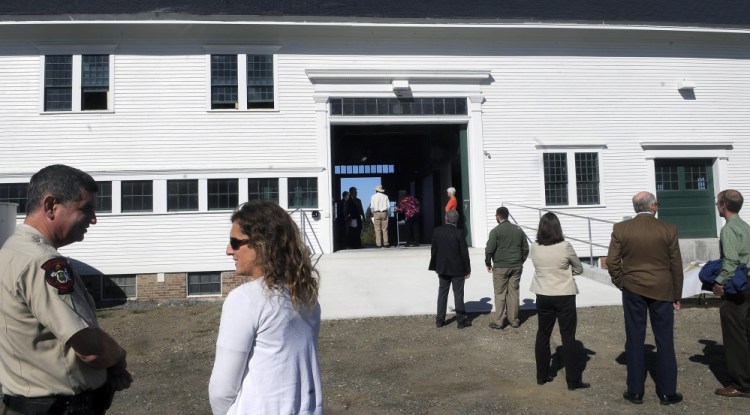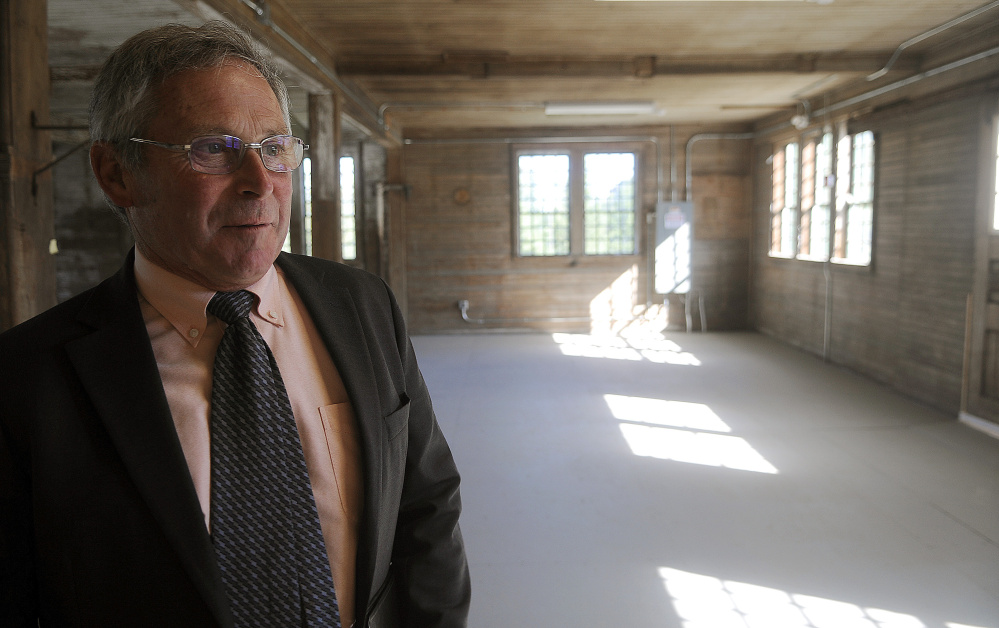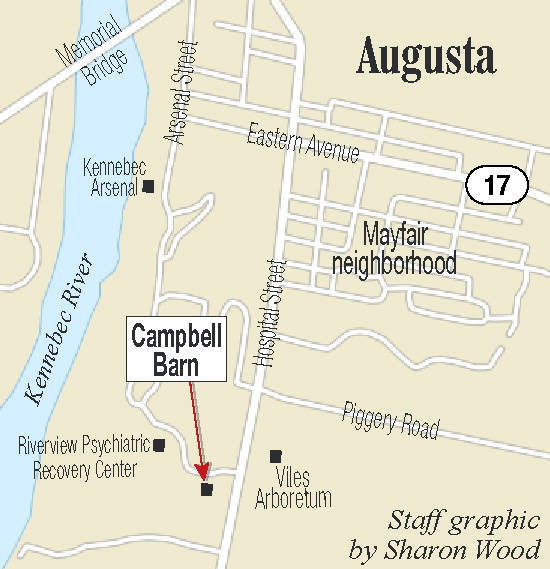AUGUSTA — The interior of the Campbell Barn, completed in 1904 on the state’s east side campus, is pristine. No smell of hay or manure. No animals neighing or mooing.
Heavy doors roll silently on overhead rails.
The concrete floors are newly poured. The wooden areas are pieced in precisely and new piping for fire alarm and sprinkler systems peek from the ceiling.
Only the top story with its wide plank floors and expansive hay-drying rack resembles a working barn.
The white clapboards gleam on the outside of the three-story historic barn that sits just off Hospital Street and close to Riverview Psychiatric Center.
Rather than housing 200 animals such as those used on the 400-acre Maine Insane Hospital’s farm, the recently renovated barn is earmarked to hold other workhorses, including the “ready boat” used by the Department of Marine Resources.
“It will give us very good access for anything that happens here on the Kennebec (River),” said Major Rene Cloutier. The Marine Patrol also uses the craft for striped bass enforcement checks.
In fact, the 158-foot-by-50-foot barn will be used for storage by three other state agencies as well: the Bureau of General Services/Surplus Property, Maine Parks & Lands and the Maine Conservation Corps.
Edward A. Dahl, director of the Bureau of General Services, welcomed representatives of all those agencies at a building re-dedication ceremony Monday to mark the completion of the $460,000-plus restoration project.
Dahl told the three dozen attendees that the barn’s deterioration had reached a structural tipping point, and it was decided to renovate it rather than remove it partly because the various agencies needed storage as a result of the closing of the state-owned Stevens School complex across the river in Hallowell.
“The reactivation of the barn cost a fraction of what new construction would have cost,” he said.
But the work, which began in the spring of 2014, wasn’t light. Some 200 tons of concrete had to be removed from the second floor.
Then the Maine State Prison Industries Program rebuilt the wide wooden doors that lead to the second floor levels, reinstalling glass panes removed from the old doors.
And a colony of bees had to be relocated.
The building now has a full security system as well.
“Saving the barn has many aspects to it,” said Walter Whitcomb, commissioner of the Department of Agriculture, Conservation and Forestry. He recalled the loss to fire of a similar barn at the University of Maine and praised the effort to save the barn in Augusta and re-purpose it to make it more functional. He also said his great-uncle worked there keeping the cattle.
State Historian Earle Shettleworth offered a historical perspective on the building and grounds, noting that hospital patients worked on the farm, a form of therapy since so many of them came from rural areas and were familiar with farming.
Records show banner years for crops, he said, including one year that produced 92 bushels of strawberries and 60 bushels of onions.
“As Mainers, barns speak to us,” said Richard Rosen, commissioner of the Department of Administrative and Financial Services. “It’s an important connection to the past, a connection to the present and a bridge to the future.”
He told the new users, “We wish you happy occupancy.”
After the re-dedication ceremony, Dahl led a group on a tour of the building. Prior to the renovation, he said, “It was filled with junk.”
He pointed to the new beams and outlined where two troughs for manure had run along the length of the ground floor.
“This is such a great old structure,” said state Rep. Donna Doore, D-Augusta, who took the tour. “I’m glad we still have it.”
According to the application form filed with the National Register of Historic Places, “The Campbell Barn replaced the barn that was acquired with the Farm Managers House in 1890. The Campbell Barn is a horse barn erected in 1903, the last of a series of farm buildings designed for the hospital by Coombs & Gibbs. The timber frame barn is traditional construction with a brick foundation partially above grade. The superstructure has clapboard siding and a slate roof with a brick chimney and three metal ventilators. The front of the barn faces east and has two small horse doors and a large hay door with transom lights interspersed with windows for the horse stalls. At the north end of the barn is the tack room with a door flanked by windows. Double doors in the south gable end were probably part of the conveyor device for manure removal.”
Betty Adams — 621-5631
Twitter: @betadams
Send questions/comments to the editors.






Success. Please wait for the page to reload. If the page does not reload within 5 seconds, please refresh the page.
Enter your email and password to access comments.
Hi, to comment on stories you must . This profile is in addition to your subscription and website login.
Already have a commenting profile? .
Invalid username/password.
Please check your email to confirm and complete your registration.
Only subscribers are eligible to post comments. Please subscribe or login first for digital access. Here’s why.
Use the form below to reset your password. When you've submitted your account email, we will send an email with a reset code.